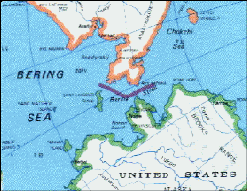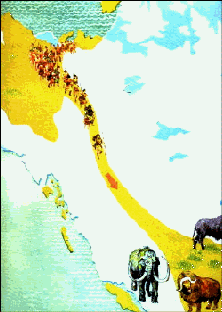|
Immigrants
Cross the Bering Strait
First Immigrants Arrive in 20,000 B.C.
In the
beginning...the earth was devoid of life as it took its place in the vastness of the Milky
Way Galaxy. Positioned in a tiny solar system, located in one of the galaxy’s
spiraling arms, it rushed through space, revolving around the galaxy’s center every
200,000,000 years. Thus, the earth began its journey through time up to five billion years
ago.
As our planet cooled and developed an atmosphere that could sustain living fauna,
flora and eventually humans, the emigration phenomena was born as animals and humans
desirous of new food, water, hunting and economic sources, ventured beyond their known
environments to become new immigrants in undiscovered faraway places. 
Today, the aboriginal peoples of the Americas, the American Indians, are considered by the rest of us as the
only truly indigenous inhabitants of North and South America. Yet, they, too, were
immigrants to these bountiful areas, crossing the Bering Strait from northern Asia around
20,000 B.C.
Their moveme nt through both continents blazed trails through deserts, mountains and
dense forests, routes that their Indian descendants used for centuries before the arrival
of America’s second wave of immigrants, the Europeans. nt through both continents blazed trails through deserts, mountains and
dense forests, routes that their Indian descendants used for centuries before the arrival
of America’s second wave of immigrants, the Europeans.
The Vikings explored North America’s northern coastal regions approximately 1,000
years ago, and, according to many historians, actually established a settlement. Nearly
five hundred years later, in the late 15th and early 16th century, explorers, adventurers,
and fortune seekers, such as Christopher Columbus (pictured at right), came, eager
to strike it rich before returning to their homelands to spread the news of
this...America.
The first great migration of Europeans to the Americas occurred during the 16th and
17th centuries. It brought essential features of western European civilization, and is
commonly referred to as the ‘colonizing period’.

Christopher Columbus
'Immigration'
segment written in November, 1997 by David
Lodge
[ Back to Immigration Index ]
|

